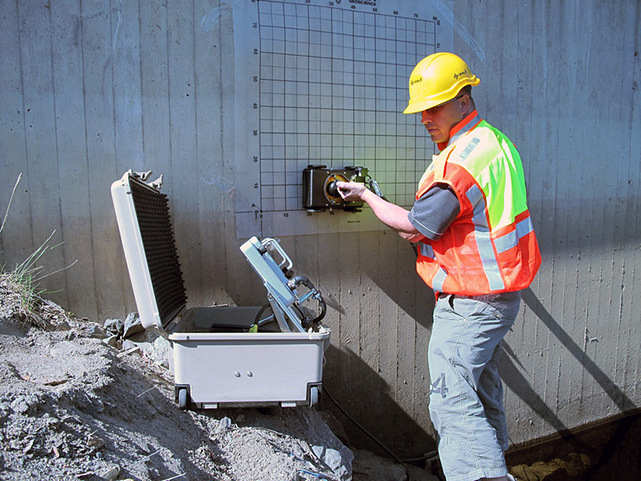Beyond the Surface Area: Leveraging Advanced Concrete Scanning Techniques for Unmatched Precision and Understanding
Advanced concrete scanning methods have actually emerged as crucial devices in this search, providing a look beneath the surface to reveal a globe of essential understandings. By utilizing sophisticated technologies, experts can reveal abnormalities, assess the problem of concrete structures, and make notified choices that form the training course of projects.
Value of Advanced Concrete Scanning
The significance of using innovative concrete scanning techniques depends on the unequaled accuracy they offer for identifying sub-surface anomalies and making certain architectural integrity. By utilizing advanced innovations such as ground-penetrating radar (GPR), electro-magnetic induction, and progressed sonar imaging, construction professionals can dig below the surface of concrete structures with a degree of accuracy that far exceeds standard examination methods. Concrete Scanning. These methods make it possible for the recognition of surprise threats like rebar deterioration, gaps, avenues, or post-tension cable televisions that might jeopardize the stability and safety of a structure with time
Moreover, progressed concrete scanning supplies invaluable understandings right into the total problem of a concrete aspect without the requirement for invasive measures, minimizing the threat of creating damages throughout the evaluation process. The ability to determine the precise place and depth of possible concerns enables targeted repairs and maintenance, ultimately lengthening the life expectancy of the structure and maximizing its performance. Basically, the significance of innovative concrete scanning can not be overstated in the realm of building and construction and facilities maintenance, where accuracy and dependability are paramount.
Kinds Of Cutting-Edge Technologies

Anomalies and Defect Discovery

In enhancement to GPR, concrete scanning strategies like thermography and impact-echo screening are additionally effective in finding defects and anomalies. Thermography utilizes infrared innovation to determine variants in surface temperature level, suggesting possible locations of worry such as delamination or dampness access. On the various other hand, impact-echo testing includes evaluating acoustic actions to find gaps, fractures, and other problems within the concrete. By leveraging these sophisticated methods, specialists can proactively attend to architectural problems, making sure the long life and security of concrete frameworks.
Assessing Concrete Condition
How can designers precisely evaluate the condition of concrete frameworks to ensure their long life and security? Numerous advanced concrete scanning methods are utilized for this objective. Ground-penetrating radar (GPR) is commonly utilized to analyze the internal structure of concrete, spotting spaces, splits, and other abnormalities that may jeopardize its stamina.
Combining non-destructive screening approaches with aesthetic examinations permits for a thorough examination of concrete problem, enabling engineers to identify possible problems early on and execute timely upkeep or fixings. By leveraging these sophisticated techniques, designers can make certain the long-lasting toughness and internet security of concrete structures.
Enhancing Decision-Making Processes
In the world of facilities administration, optimizing decision-making processes is necessary for ensuring the effective upkeep and long life of concrete structures. Improved decision-making procedures in concrete monitoring include utilizing innovative scanning methods to gather thorough data on the condition of frameworks. By leveraging modern technologies such as ground-penetrating radar and 3D imaging, stakeholders can make educated choices relating to repair work, substitute, or reinforcement methods.
These advanced scanning methods provide very useful insights right into the internal structure of concrete, recognizing potential problems such as voids, fractures, or deterioration that might not show up externally. This level of in-depth details allows for positive upkeep planning, lessening the danger of architectural failures and enhancing the general life-span of concrete structures.
Additionally, by integrating electronic documents and evaluation tools into the decision-making procedure, stakeholders can track the advancement of concrete conditions over time, allowing anticipating upkeep methods and optimizing resource allowance. Eventually, the assimilation of advanced concrete scanning methods improves decision-making processes by supplying unequaled precision, understanding, and performance in infrastructure management.
Verdict
Finally, advanced concrete scanning methods use unrivaled accuracy and insight in detecting anomalies, defects, and evaluating the problem of concrete frameworks. By leveraging sophisticated modern technologies, decision-making procedures can be improved, leading to more enlightened and effective solutions for keeping and fixing concrete facilities. These techniques play an important role in ensuring the safety and security and durability of concrete structures, making them an essential device in the field of construction and design.
Additionally, advanced concrete scanning gives vital insights right into the overall problem of a concrete element without the demand for invasive steps, minimizing the danger of causing damages during the evaluation process - Concrete Scanning. An additional innovative innovation is 3D X-ray scanning, which offers detailed pictures of the inner structure of concrete, her comment is here offering useful information without the requirement for harmful screening. Furthermore, Concrete Cover Meters are made use of to measure the thickness of concrete cover over support bars accurately. Improved decision-making procedures in concrete management include utilizing sophisticated scanning strategies to gather comprehensive information on the problem of structures.In final thought, advanced concrete scanning methods supply unequaled accuracy and insight in finding abnormalities, problems, and analyzing the condition of concrete structures